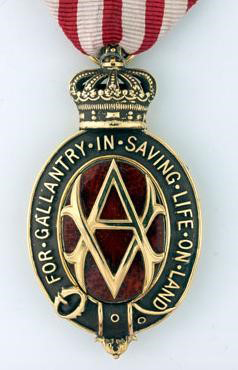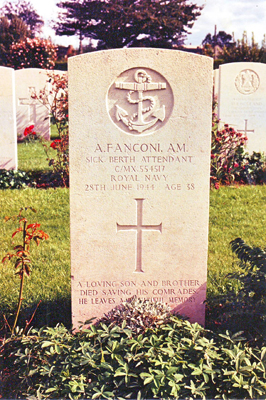Arturio Fanconi - Sick Berth Attendant
S.B.A., Arturio FANCONI, A.M., C/MX 554517, Royal Navy
In 1992 whilst on the way back from a Family holiday at Disney World in France, we stopped off at the Bayeux War Cemetery.
Like many before me I was stunned by the rows and rows of white headstones shining in the sun and the peacefulness of the whole place. I just wandered around and stopped somewhere towards the rear of the cemetery and looked back to take it all in. As I turned round for one last look, before the rest of my journey home. I was stunned to find I’d stopped in front of a war grave to the memory of a RN SBA. How weird was that?
I took this photograph at the time.
Only recently have I come across the photograph again, which has brought the story back to me. So a quick look on the internet (not so 20 years ago!) and 1/2 hour later I discovered the following:
Sick Berth Attendant, Arturio FANCONI, C/MX 554517, Royal Navy, Died – 28th June 1944 aged 38. Posthumously awarded The Prince Albert Medal (in Gold).
SBA FANCONI was of Swiss extraction and the son of Giulio and Anna Fanconi. Resident in Illminster, Somerset. It is recorded that he had an interest in First Aid and Volunteered to join the Royal Navy as a Sick Birth Attendant. Records show that he was attached to HMS Odyssey which, in fact, was a Combined Operations Base operating out of the Collingwood Hotel, Ilfracombe. (I think this was the Pay and records for Combined Ops at the time, so he could have been attached to a Naval Party almost anywhere.)However he found himself on UTAH Beach in Normandy around D Day in June 1944, with the Americans. I assume from the ‘O’ and ‘G’ LCT Squadrons that were supporting the American landings. Hence, SBA FANCONI’s connection with Combined Operations.
This story is placed around Quineville which is just north of UTAH Beach on the east cost of the Cherbourg Peninsula and was in the thick of the Battle “Objectiv un Port” as the Allied forces pushed northwards to regain Cherbourg)
There is apparently a letter in a Museum at Quineville from a Colonel of the American Regiment that was involved that relates to SBA FANCONI’s gallant acts.
The Citation on the War Graves Commission web site says:
An extract taken from the “London Gazette” records the following: “On 28th June, 1944, Fanconi was summoned to help men wounded by mines at Quineville. He at once ran almost half a mile and went through what later proved to be a field of anti-personnel mines to reach them. He applied tourniquets and bandages; then, with help, carried two patients out of the drive which was the scene of the incident. This was a tiring and difficult task as it entailed hugging a wall all the way. Fanconi was on the more dangerous side throughout. While the rescue party were considering how best to help a third man who lay some distance within the minefield, another mine burst beneath the rubble on which they stood. This killed one helper and wounded Fanconi and another. Despite this, Fanconi tried to collect his scattered medical kit and to help his comrade. He had to crawl to do so, and was in great pain. In his attempt, he exploded a further mine which blew off one of his feet. The explosion hurled him into the air, and when he fell set off a third mine which severed his other foot. A corporal made every effort to help him, but the kit was now of little use and Fanconi could not be saved. All who had witnessed his selfless courage, his speed and skill in giving aid to others, all the while exposing himself to immediate danger, were inspired by his great example.”
It makes you think lots when you read this and then listen to the radio and television of whatís going on in Afghanistan today………..enough said really.
John Bright
Ex CPOMA 1971 – 2000
Lest we forget: “…….at the going down of the sun and in the morning, we will remember them”.
The Albert Medal
Named after the Prince Consort (who had died in 1861) this medal was awarded for gallantry in life saving at sea and on land. In 1949 the Albert Medal in Gold was replaced by the George Cross. Holders of this medal were invited to exchange their medals for the George Cross. Some 49 of 64 did so.


